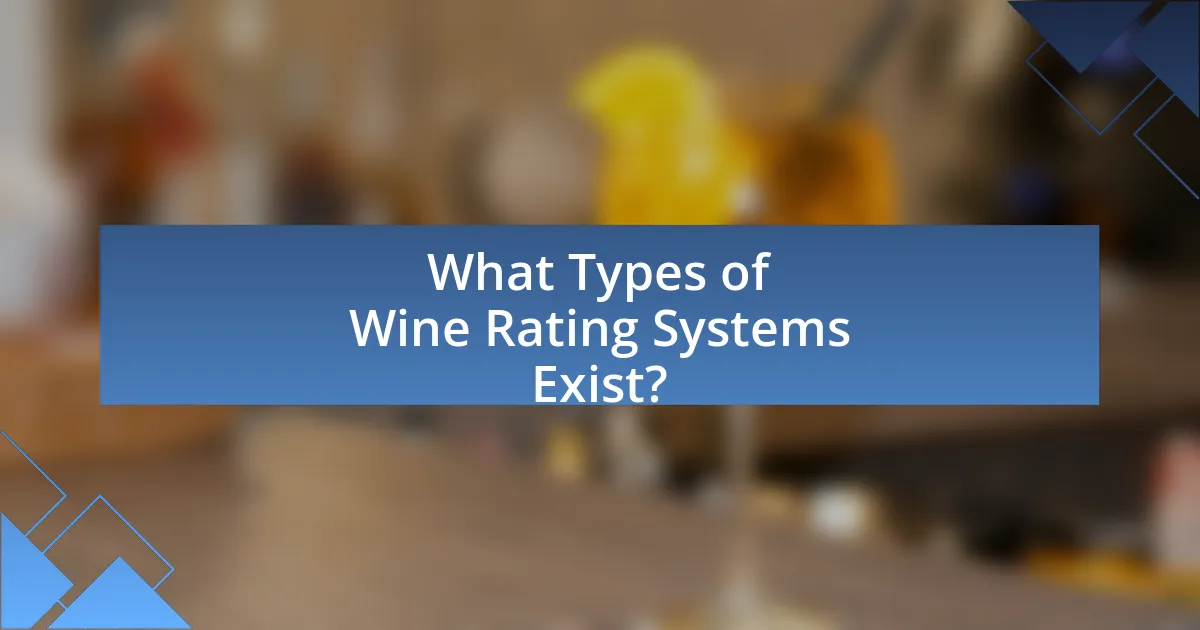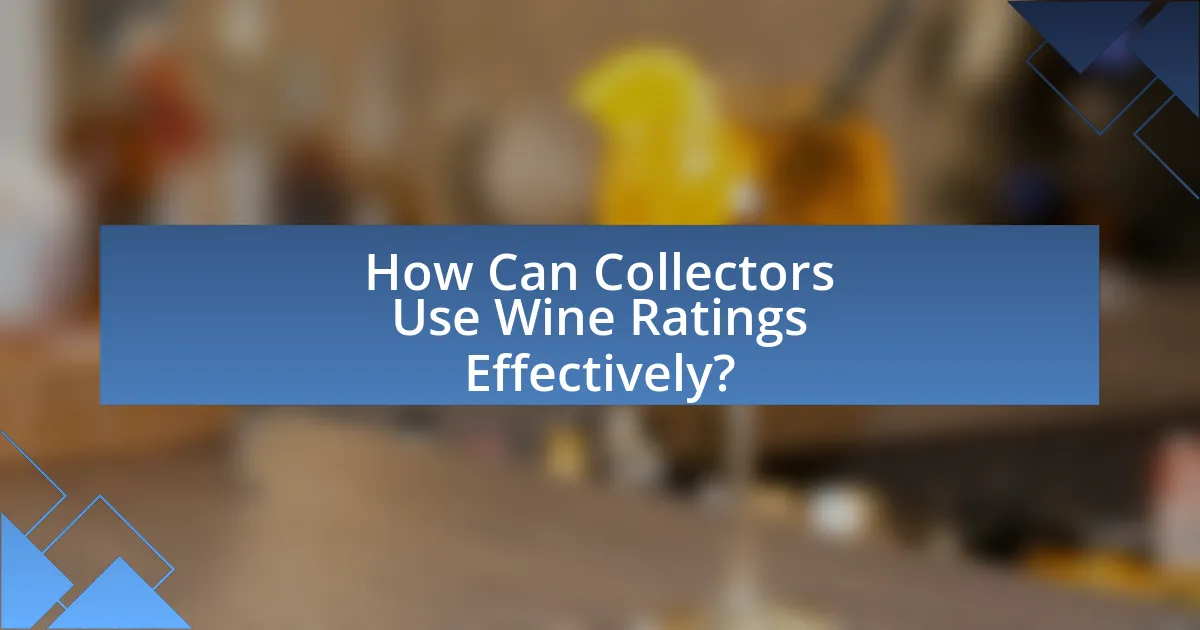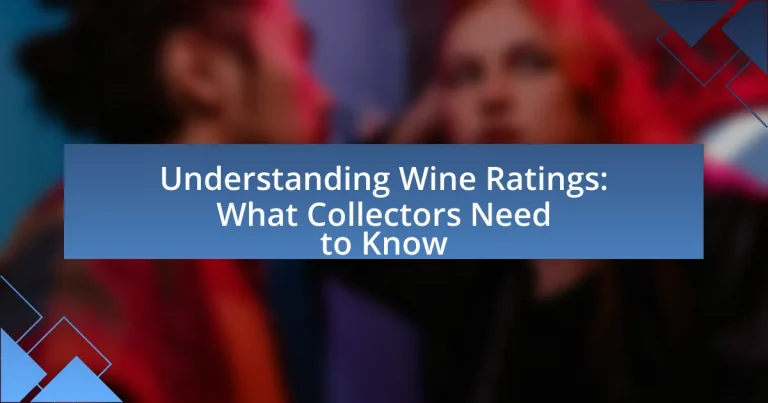Wine ratings are numerical scores or qualitative assessments assigned to wines based on their quality, taste, and characteristics, primarily by wine critics and organizations. These ratings guide consumers and collectors in making informed purchasing decisions, with higher scores indicating exceptional quality. The article explores how wine ratings are determined, the criteria used by critics, and the roles of key players in the wine rating landscape. It also examines the differences between consumer and expert ratings, various rating systems, and strategies for collectors to effectively utilize wine ratings while balancing personal preferences. Additionally, it highlights common mistakes to avoid when interpreting ratings, ensuring collectors can enhance their understanding and appreciation of wine quality.

What are Wine Ratings and Why Do They Matter?
Wine ratings are numerical scores or qualitative assessments given to wines based on their quality, taste, and characteristics, typically provided by wine critics or rating organizations. These ratings matter because they serve as a guide for consumers and collectors, helping them make informed purchasing decisions and understand the relative quality of different wines. For instance, a wine rated 90 points or higher by a reputable critic is often considered exceptional, influencing its market value and desirability among collectors.
How are Wine Ratings Determined?
Wine ratings are determined through a combination of sensory evaluation and scoring systems employed by wine critics and organizations. Evaluators assess various attributes such as aroma, flavor, body, acidity, and finish, often using a standardized scoring scale, typically ranging from 50 to 100 points. For instance, the 100-point scale, popularized by Robert Parker, assigns higher scores to wines that exhibit exceptional quality, complexity, and balance. Additionally, factors like vintage, terroir, and winemaking techniques are considered, providing context for the ratings. This systematic approach ensures that wine ratings reflect both subjective experiences and objective criteria, allowing collectors to make informed purchasing decisions.
What criteria do wine critics use for ratings?
Wine critics use several criteria for ratings, including appearance, aroma, taste, mouthfeel, and finish. The appearance involves assessing color and clarity, while aroma evaluates the complexity and intensity of scents. Taste focuses on flavor profile, balance, and overall enjoyment. Mouthfeel examines texture and weight, and finish considers the length and quality of the aftertaste. These criteria are standardized in many wine competitions and publications, ensuring consistency and reliability in ratings. For instance, the 100-point scale, commonly used by critics, assigns scores based on these factors, providing a quantifiable measure of quality.
How do tasting notes influence wine ratings?
Tasting notes significantly influence wine ratings by providing detailed descriptions of a wine’s aroma, flavor, and overall experience, which help reviewers and consumers assess quality. These notes serve as a standardized language that conveys the sensory attributes of a wine, allowing for consistent evaluation across different wines and vintages. For instance, a wine rated highly often features complex tasting notes that highlight desirable characteristics such as balance, depth, and finish, which are critical factors in the scoring process used by wine critics and rating organizations. Studies have shown that wines with well-articulated tasting notes tend to receive higher ratings, as they guide the perception of quality and enhance the overall appreciation of the wine.
Who are the Key Players in Wine Ratings?
The key players in wine ratings include wine critics, publications, and organizations that evaluate and score wines. Notable wine critics such as Robert Parker and James Suckling have significant influence due to their established reputations and extensive tasting experience. Publications like Wine Spectator and Wine Enthusiast provide widely recognized ratings and reviews, impacting consumer choices and market trends. Additionally, organizations such as the International Wine Challenge and Decanter World Wine Awards contribute to the credibility of wine ratings through structured judging processes and expert panels. These entities collectively shape the landscape of wine ratings, guiding collectors and consumers in their purchasing decisions.
What roles do wine critics and publications play?
Wine critics and publications serve as authoritative sources that evaluate and rate wines, influencing consumer choices and market trends. They provide detailed assessments based on criteria such as aroma, flavor, and overall quality, which help consumers make informed purchasing decisions. For instance, a high rating from a reputable critic can significantly increase a wine’s visibility and sales, as evidenced by the impact of Robert Parker’s ratings on wine prices in the market. Additionally, these critics and publications often educate the public about wine regions, varietals, and production methods, enhancing overall wine appreciation and knowledge among consumers.
How do consumer ratings differ from expert ratings?
Consumer ratings differ from expert ratings primarily in their basis of evaluation; consumer ratings reflect personal preferences and experiences, while expert ratings are grounded in professional knowledge and established criteria. Consumers often rate wines based on subjective enjoyment, accessibility, and price, leading to a broader range of scores influenced by individual taste. In contrast, experts utilize systematic tasting methods, industry standards, and extensive experience, resulting in more consistent and reliable assessments. For instance, a study published in the Journal of Wine Economics found that expert ratings tend to correlate more closely with wine quality indicators, such as vineyard reputation and production methods, compared to consumer ratings, which can be swayed by marketing and personal bias.

What Types of Wine Rating Systems Exist?
Various wine rating systems exist, including the 100-point scale, the 20-point scale, and qualitative descriptors. The 100-point scale, popularized by critics like Robert Parker, assigns scores from 50 to 100 based on quality, with scores above 90 indicating exceptional wines. The 20-point scale, used by organizations such as the Wine Enthusiast, evaluates wines on a more concise scale, focusing on specific attributes like aroma, flavor, and finish. Qualitative descriptors, often employed in tasting notes, provide a narrative evaluation of a wine’s characteristics without numerical scoring. These systems help consumers and collectors assess wine quality and make informed purchasing decisions.
How do Point Systems Work in Wine Ratings?
Point systems in wine ratings assign numerical scores to wines based on various criteria, such as aroma, flavor, and overall quality. These scores typically range from 50 to 100, with higher scores indicating better quality. For example, a wine rated 90 points is generally considered outstanding, while a score of 80 indicates a good wine. The scoring is often based on a combination of expert reviews and standardized tasting protocols, ensuring consistency and reliability in evaluations. Many wine critics and publications, such as Wine Spectator and Robert Parker’s Wine Advocate, utilize these point systems to guide consumers and collectors in their purchasing decisions.
What is the significance of a 100-point scale?
The significance of a 100-point scale lies in its ability to provide a standardized method for evaluating and comparing the quality of wines. This scale allows wine critics and consumers to assess wines based on specific criteria such as aroma, flavor, and overall balance, facilitating informed purchasing decisions. For instance, wines rated above 90 are often considered exceptional, while those below 70 may be deemed poor quality. The widespread adoption of this scale by prominent wine publications, such as Wine Spectator and Robert Parker’s Wine Advocate, underscores its importance in the wine industry, as it influences consumer preferences and market trends.
How do different publications use point systems?
Different publications use point systems to evaluate and rate wines, providing a standardized method for consumers to assess quality. For instance, Wine Spectator employs a 100-point scale where wines rated 90-94 are considered outstanding, while those rated 95 and above are exceptional. Similarly, Robert Parker’s Wine Advocate uses a 100-point scale, emphasizing the importance of consistency and reliability in ratings, which influences purchasing decisions among collectors. These point systems help create a common language for wine quality, allowing collectors to compare wines across different regions and vintages effectively.
What are Alternative Wine Rating Methods?
Alternative wine rating methods include crowd-sourced ratings, numerical scoring systems, and qualitative reviews. Crowd-sourced ratings leverage platforms where consumers share their experiences, providing a diverse range of opinions that can reflect broader preferences. Numerical scoring systems, such as those used by various wine publications, assign a score based on specific criteria like aroma, taste, and finish, allowing for quick comparisons. Qualitative reviews focus on descriptive language to convey the wine’s characteristics, offering insights that numbers alone may not capture. These methods provide collectors with varied perspectives, enhancing their understanding of wine quality beyond traditional rating systems.
How do star ratings compare to point ratings?
Star ratings and point ratings serve as systems for evaluating wine quality, but they differ in their scale and interpretation. Star ratings typically use a scale from one to five stars, where five indicates exceptional quality, while point ratings often utilize a 100-point scale, with scores above 90 representing high-quality wines. Research shows that point ratings provide a more granular assessment, allowing for finer distinctions between wines, whereas star ratings offer a simpler, more intuitive understanding for consumers. This distinction is crucial for collectors, as point ratings can reflect subtle differences in quality that may influence purchasing decisions.
What is the impact of numerical vs. descriptive ratings?
Numerical ratings provide a quantifiable measure of quality, while descriptive ratings offer qualitative insights into the characteristics of a wine. Research indicates that numerical ratings, such as scores from 1 to 100, can simplify comparisons and facilitate quick decision-making for collectors. However, descriptive ratings enhance understanding by detailing flavor profiles, aromas, and overall experience, which can influence a collector’s appreciation and choice. A study published in the Journal of Wine Economics found that consumers often rely on numerical scores for initial assessments but prefer descriptive language for deeper engagement with the product. This dual impact suggests that both rating systems serve distinct but complementary roles in wine evaluation.

How Can Collectors Use Wine Ratings Effectively?
Collectors can use wine ratings effectively by leveraging them to make informed purchasing decisions and to assess the quality and potential value of wines. Wine ratings, often provided by critics and publications, offer a standardized evaluation of a wine’s characteristics, helping collectors identify high-quality options. For instance, wines rated 90 points or above are generally considered exceptional and may appreciate in value over time. Additionally, collectors can compare ratings across different sources to gain a comprehensive understanding of a wine’s reputation and market demand, as seen in the Wine Advocate and Wine Spectator ratings, which are widely recognized in the industry. By utilizing these ratings, collectors can enhance their collections strategically, ensuring they invest in wines that are likely to yield both enjoyment and financial return.
What Should Collectors Look for in Wine Ratings?
Collectors should look for consistency, credibility, and context in wine ratings. Consistency refers to how often a wine receives similar scores from various critics or publications, indicating reliability in quality. Credibility involves the reputation of the rating source; established critics or well-known publications like Wine Spectator or Robert Parker’s Wine Advocate are more trustworthy. Context includes understanding the vintage, region, and varietal characteristics, as these factors can significantly influence a wine’s rating. For example, a 95-point rating from a reputable source for a Bordeaux vintage known for excellence can indicate a wine of exceptional quality.
How can ratings guide purchasing decisions?
Ratings can significantly guide purchasing decisions by providing a quantifiable assessment of a product’s quality, which helps consumers make informed choices. In the context of wine, ratings from reputable sources, such as Wine Spectator or Robert Parker, offer insights into the wine’s flavor profile, aging potential, and overall quality. For instance, a wine rated 90 points or higher is often considered exceptional, influencing collectors and buyers to prioritize those selections over lower-rated options. Research indicates that consumers are more likely to purchase products with higher ratings, as these ratings serve as a heuristic for quality assurance, reducing perceived risk in the buying process.
What are the limitations of relying solely on ratings?
Relying solely on ratings has significant limitations, primarily due to their subjective nature. Ratings can vary widely based on individual preferences, biases, and the context in which the wine is tasted, leading to inconsistent evaluations. For instance, a wine rated highly by one critic may not resonate with another, as personal taste plays a crucial role in wine appreciation. Additionally, ratings often lack comprehensive context, such as the wine’s age, storage conditions, or food pairings, which can greatly influence the tasting experience. Furthermore, the rating system may not account for the evolving nature of wine, where a bottle can change significantly over time. This variability can mislead collectors who rely solely on numerical scores without considering qualitative aspects.
What Strategies Can Enhance a Collector’s Understanding of Wine Ratings?
To enhance a collector’s understanding of wine ratings, engaging with reputable wine publications and databases is essential. These resources provide detailed reviews and ratings from experts, helping collectors grasp the nuances of wine quality. Additionally, attending wine tastings and educational seminars allows collectors to experience wines firsthand and learn how ratings correlate with sensory attributes. Furthermore, joining wine clubs or online forums fosters discussions with other collectors and enthusiasts, facilitating knowledge exchange about ratings and their implications. Collectors should also familiarize themselves with different rating systems, such as the 100-point scale, to better interpret scores and reviews.
How can collectors develop their own tasting skills?
Collectors can develop their own tasting skills by practicing systematic tasting techniques and engaging in regular exposure to a variety of wines. Systematic tasting involves evaluating wines based on appearance, aroma, taste, and finish, which helps in identifying specific characteristics and nuances. Regular exposure to different wine styles, regions, and vintages enhances sensory memory and improves the ability to discern subtle differences. Research indicates that consistent practice and exposure can significantly enhance tasting proficiency, as seen in studies on sensory training in wine professionals.
What resources are available for learning about wine ratings?
Resources available for learning about wine ratings include wine rating websites, books, and industry publications. Websites such as Wine Spectator and Robert Parker’s Wine Advocate provide comprehensive ratings and reviews from experts. Books like “The Wine Bible” by Karen MacNeil offer in-depth knowledge about wine ratings and tasting. Additionally, industry publications such as Decanter magazine feature articles and insights on wine ratings, helping collectors understand the nuances of wine evaluation. These resources collectively provide a solid foundation for anyone looking to learn about wine ratings.
What Best Practices Should Collectors Follow When Using Wine Ratings?
Collectors should prioritize using multiple wine ratings from reputable sources to make informed purchasing decisions. By consulting various rating systems, such as those from Wine Spectator, Robert Parker, and Wine Enthusiast, collectors can gain a more comprehensive understanding of a wine’s quality. Additionally, collectors should consider the context of the ratings, including the vintage, region, and critic’s tasting notes, as these factors can significantly influence a wine’s perceived value. Research indicates that wines rated above 90 points often appreciate in value, making high ratings a critical factor in investment decisions. Therefore, utilizing a diverse range of ratings and understanding their context enhances a collector’s ability to select wines that align with both personal preferences and investment goals.
How can collectors balance ratings with personal preferences?
Collectors can balance ratings with personal preferences by critically evaluating wine ratings while considering their own taste profiles. Wine ratings, often provided by critics or publications, serve as a guideline for quality and market value; however, personal preferences are shaped by individual experiences and flavor profiles. For instance, a collector may find that a highly rated wine does not align with their palate, leading them to prioritize personal enjoyment over external validation. Research indicates that personal taste can significantly influence purchasing decisions, as seen in a study published in the Journal of Wine Economics, which found that consumers often prefer wines that resonate with their unique flavor preferences, even if those wines are not highly rated. Therefore, collectors should use ratings as a reference point but ultimately trust their own taste to make informed decisions.
What common mistakes should collectors avoid when interpreting ratings?
Collectors should avoid over-relying on numerical ratings without considering the context of the wine. Ratings can vary significantly based on the reviewer’s palate, the wine’s age, and the specific tasting conditions. For instance, a wine rated highly by one critic may not align with another’s preferences, leading to misinterpretation of its quality. Additionally, collectors often mistake high ratings as guarantees of future value, ignoring market trends and the wine’s provenance. Understanding that ratings are subjective and can fluctuate over time is crucial for making informed purchasing decisions.


